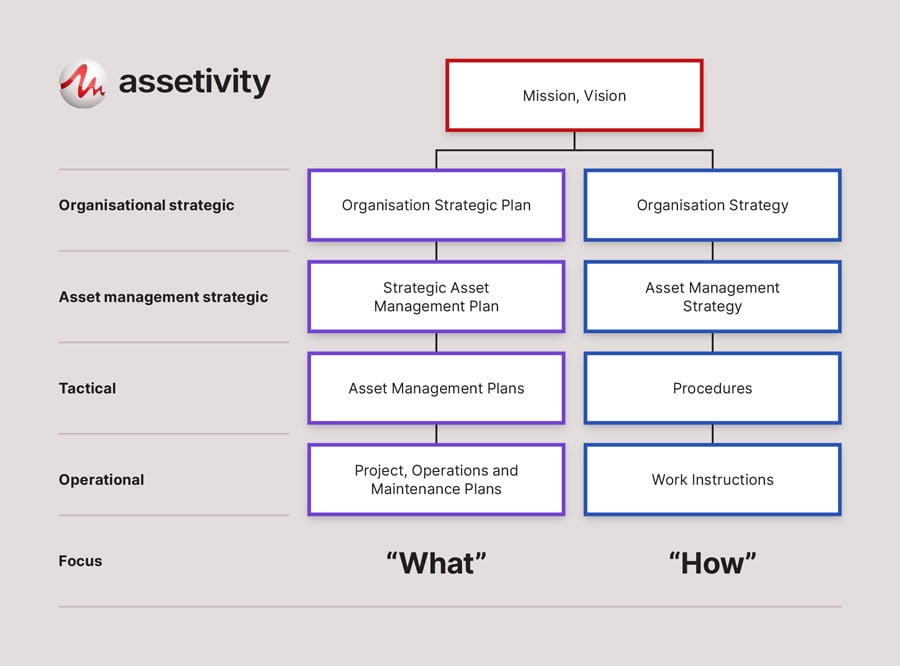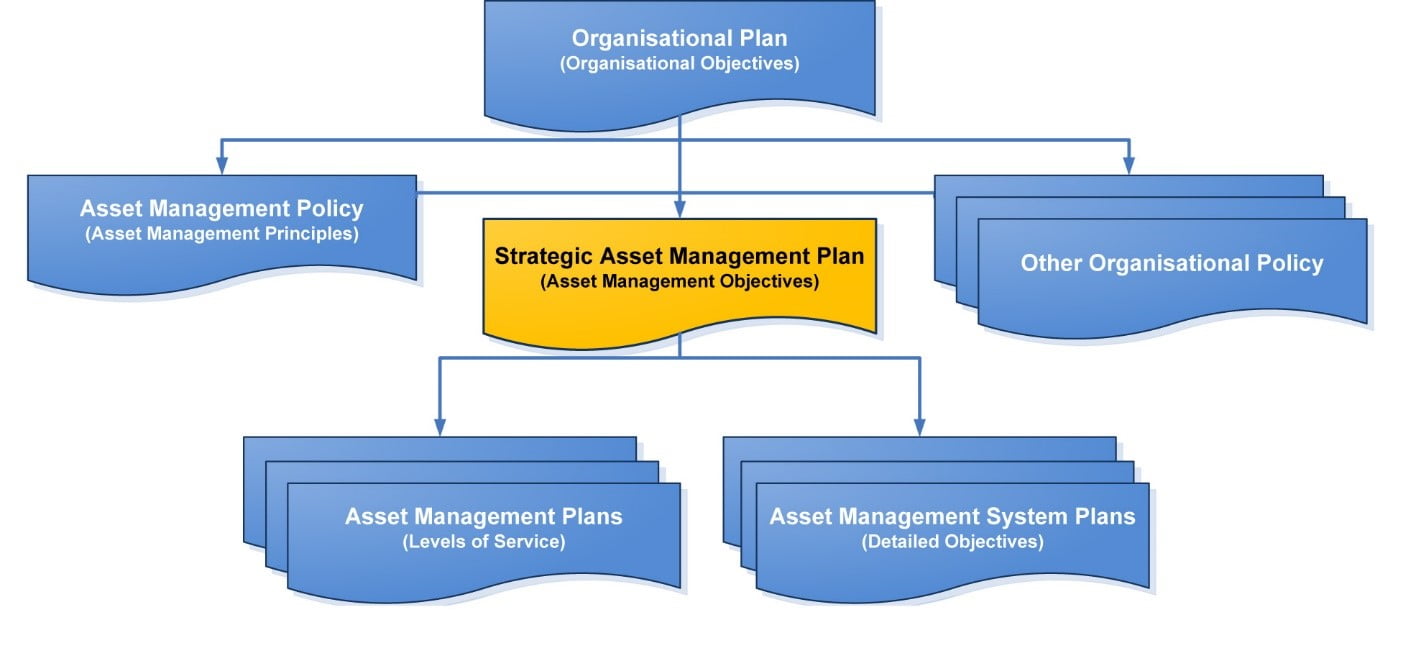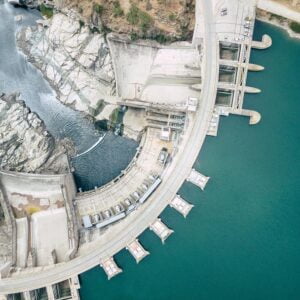This article discusses what we think a good Strategic Asset Management Plan should look like, and is the fourth in a series of 13 articles on Implementing ISO 55000.
Articles in this series
In another article “Asset Management Strategy vs Strategic Asset Management Plan (SAMP) – A Practical Approach”, we recommended that an organisations strategic approach to Asset Management be split amongst two documents:
- An Asset Management Strategy, which outlines the high level, strategic approach that the organisation takes to Asset Management. In other words, how it proposes to manage its assets
- A Strategic Asset Management Plan, which contains the longer-term, higher level strategic initiatives that the organisation must take in order to execute its Asset Management Strategy.
Taking this approach results in documents that are shorter in length and are:
- Aimed at different audiences for different purposes, and therefore more likely to be used
- Able to be more easily updated, and therefore more likely to be current and relevant.
In this article, we go into more detail regarding what a good Strategic Asset Management Plan document may look like. In another article “What does a good Asset Management Strategy look like?”, we discuss the key elements of a good Asset Management Strategy.
Asset management strategy vs Strategic Asset Management Plan (SAMP)
As discussed in our article “Asset Management Strategy vs Strategic Asset Management Plan (SAMP) – A Practical Approach”, we take issue with the approach and definitions used within ISO 55000 and ISO 55002.
ISO 55000 states that a Strategic Asset Management Plan is “documented information that specifies how organizational objectives are to be converted into asset management objectives, the approach for developing asset management plans, and the role of the asset management system in supporting achievement of the asset management objectives” (ISO 55000:2014 p.14 – emphasis added).
This suggests that the SAMP should specify how things are to be done, rather than what should be done. This is reinforced by statements in ISO 55000 that state that “The principles by which the organization intends applying asset management to achieve its organizational objectives should be set out in an asset management policy. The approach to implementing these principles should be documented in a strategic asset management plan (SAMP)” (ISO 55000:2014 p8).
ISO 55002 further reinforces this view by stating that “The SAMP details the asset management objectives, explains their relationship to the organizational objectives and the framework required to achieve the asset management objectives” (ISO 55002:2018 p.6).
This, to our (and most people’s) way of thinking is not the definition of a plan. It is, however, a pretty good definition of an Asset Management Strategy. The confused thinking in ISO 55001 relating to the difference between a Strategy and a Strategic Plan is only highlighted by the notes in both ISO 55000 and ISO 55002 which state that “A strategic asset management plan can be referred to by other names, e.g. an asset management strategy” (ISO 55000:2014 p8), and “A SAMP can be referred to by other names, e.g. ‘asset management strategy’”(ISO 55002:2018 p.6). No wonder there is confusion amongst those trying to interpret ISO 55001.
We think it essential that you consider who will use the SAMP and/or Asset Management Strategy and what they will use them for. Further, you should carefully consider the size of each document, and the amount of effort involved in updating them.
We find it helpful to visualise the difference between strategies and plans using the following diagram which clearly distinguishes an Asset Management Strategy as describing how you manage your assets vs a Strategic Asset Management Plan which describes what you need to do to achieve Asset Management Objectives within the context of your Asset Management Strategy.

The SAMP has a pivotal role in the Asset Management document hierarchy. It links organisational objectives to Asset Management objectives, and outlines the high level, strategic actions that are required in order to ensure that the Asset Management objectives are achieved. In turn, this should ensure that the organisation’s Asset Management activities are contributing effectively to the achievement of overall organisational objectives.

The SAMP, in turn, provides guidance for the development of lower level objectives, and the more detailed Asset Management Plans for achieving those lower level objectives.
It is, therefore, a key communication tool, both upwards and downwards. Consequently, the SAMP will be “good” if it delivers the right information to the right people at the right time. Let’s look at each of these individually.
Having the “right information” obviously includes ensuring that appropriate, achievable Asset Management objectives have been developed and documented. This is mostly dependent on carving out an appropriate role for Asset Management planning within the organisation’s overall business planning process. This can be a challenge since most organisations have been undertaking business planning for a long time but have only recently tried to introduce formal Asset Management planning. Consequently, we often see situations where SAMPs and Asset Management Plans have been developed independently of other organisational business plans (and budgets) as a standalone exercise, and are therefore not properly “joined up” or aligned with those other plans.
While the “right people” will clearly vary with organisational structure, the users of the SAMP usually aren’t in the Asset Management area, since these people already know what is happening within this area. The most common users are:
- Executives, who need to understand what the assets (and the Asset Management system) are going to deliver, who will approve the plans (and proposed resources) and will want to track progress towards achievement of the plan
- Technical and/or Asset managers, who need to write the detailed Asset Management plans for their specific assets
- Other managers (administration, finance, human resources, learning and development, procurement and project), who need to understand the Asset Management system and what they need to deliver to support it
Delivering the information at the “right time” is more about the method of delivery, since the SAMP is always there waiting. The key is to ensure that the document is presented in a way that lets the “right people” get the information they need, which implies a short, readable document that clearly lays out the Asset Management objectives and strategic initiatives with enough background to understand why they are important and appropriate.
Compliance requirements and guidance
Since ISO 55000 conflates both Asset Management Strategy and Strategic Asset Management Plan into one document, we need to understand the ISO 55001 requirements that may relate to the Strategic Asset Management Plan. Surprisingly, we find that the standard does not actually require very much of the SAMP at all. In fact, it only specifically requires inclusion of the Asset Management objectives (ISO 55001:2014, pp.1, 4) and documentation of the role of the Asset Management system in delivering the Asset Management objectives (ISO 55001:2014, p.2). There are a few implied requirements such as clause 4.3, which requires the scope of the Asset Management system to be aligned with the SAMP (ISO 55001:2014, p.2) and therefore implies that the SAMP must provide a basis for this, and clause 6.2.2, which similarly implies the SAMP must provide a basis for establishing the subordinate Asset Management plans required to achieve the Asset Management objectives (ISO 55001:2014, pp.4-5).
There are also a few other items that are required by ISO 55001 as documented information and are therefore candidates for inclusion in the SAMP (ISO 55001:2014, pp. 4-5). These include:
- The actions to be taken, including resources, responsibilities, timeframes and evaluation methods
- The planning time horizons and review periods
- The implications of the plans
- Actions to address risks and opportunities
Overall, however, there is little guidance on the content of a SAMP within ISO 55001.
The 2018 version of ISO 55002 provides more detailed guidance and recommendations regarding the content of the SAMP in Annex C (ISO 55002:2018, pp. 51-55). This includes a recommended list of 18 individual content elements, some with sub-elements that include the following:
- an overview of the organization’s context, i.e. external and internal issues
- strategic asset management objectives derived from organizational objectives
- the asset portfolio-level plan, and the associated financial plan, to achieve the strategic asset management objectives
- plans for creating or improving the asset management system
- arrangements for the review, update and improvement of the SAMP
Strategic asset management plan contents
As mentioned earlier, the intent behind this document is that it describes what the organisation is planning to do in order to ensure that Asset Management objectives are achieved. Being a strategic document, it should describe the high-level strategic initiatives that the organisation is putting in place in order to meet those objectives while aligning with the strategic approach to Asset Management contained in the Asset Management Strategy. Its possible contents include the following:
- Executive Summary – the key points from the remainder of the document for the benefit of the time-poor:
- Scope and Purpose of the Document– what it covers, what it is intended to be used for, and who its intended audience is:
- Context – a summary of the relevant factors that have impacted on the development of the plan to allow the reader to understand why the selected Strategic Initiatives have been selected. This could include brief discussion of the following:
- Organisational context and Organisational Objectives
- Relevant Stakeholder needs (regulators, customers, staff, owners…)
- Asset portfolio (general description and condition)
- Asset Management system (general description and condition, including process maturity and workforce competence)
- Relevant considerations from the Asset Management Strategy
- Performance – Desired and Forecast – a comparison of desired levels of performance required from assets and the asset management system versus those that are expected to be achieved based on an assumption of “business as usual”. This section should include:
- Asset Management objectives, mapped to the organisational objectives
- Forecast levels of performance, assuming business as usual
- Identified current and future performance gaps
- Assumptions – detail of any assumptions that have been made in developing the SAMP.
- Strategic Initiatives – a description of the selected strategic initiatives to bridge the identified gaps in performance, including:
- Mapping against the Asset Management objectives
- Targets and measures (including links to levels of service in subordinate plans)
- Relative priorities
- Timeframes
- Accountabilities
- Resources required for each initiative, including funding
- Resource Summary – a summary of the financial and other resources needed to undertake the strategic initiatives and achieve the required objectives. This should include:
- Operating Expenditure Forecast
- Capital Expenditure Forecast
- Manning Requirements
Where the forecasts in the SAMP vary from those currently included in budgets, the relevant variations should be highlighted.
- Risk and Opportunities – this section should outline the key risks that are associated with the plan. This should include any risks related to assumptions made in preparing the plan, dependencies between activities within and external to the plan as well as any other significant issues. How these risks will be managed should also be summarised in this section
- Appendices – to capture any supporting detail required that is too lengthy to include in the body of the SAMP.
The SAMP is a high-level management planning document and our recommendation is that it should be relatively short in length and action-oriented so that it can be easily read and updated as required.
Looking for further training in ISO 55001 certification?
We offer a range of asset management courses, some of which specialise in ISO 55001 deliverables. If you are interested in reading more about our courses, you can do so by following the links below.
-
Product on sale
 Implementing an ISO 55001 Compliant Asset Management SystemOriginal price was: $2,275.00.$2,047.50Current price is: $2,047.50.
Implementing an ISO 55001 Compliant Asset Management SystemOriginal price was: $2,275.00.$2,047.50Current price is: $2,047.50. -
Product on sale
 Asset Management Foundation AwardOriginal price was: $1,195.00.$1,075.50Current price is: $1,075.50.
Asset Management Foundation AwardOriginal price was: $1,195.00.$1,075.50Current price is: $1,075.50.


